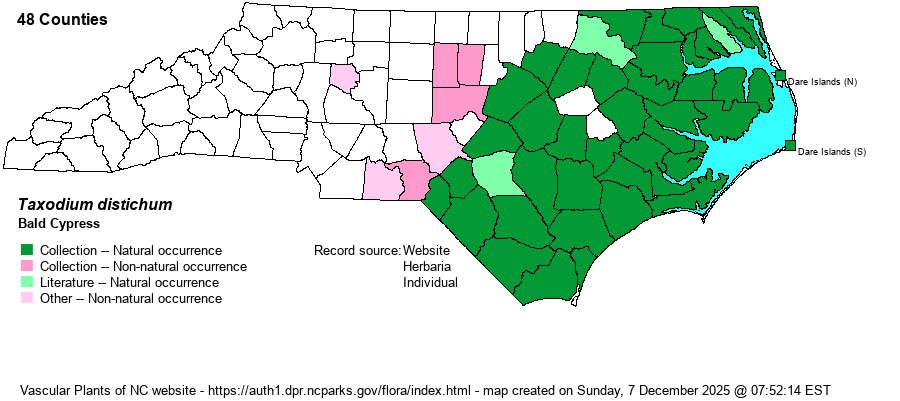| Author | (L.) L.C. Richard | |
| Distribution | Essentially throughout the Coastal Plain, including northern Outer Banks. Also ranges sparingly into the eastern Piedmont, mainly in Wake and Franklin counties. Records farther west likely are of planted or escaped individuals. One editor (Sorrie) believes that specimens from Alamance, Anson, Chatham, Moore, and Richmond counties are correctly identified, but from artificial ponds and lakes, thus almost surely non-natural occurrences.
This species, generally confined to the Coastal Plain, ranges north to DE and eastern MD, south to southern FL, and west upwards in the Mississippi River valley to southern IL and MO. It ranges southwest to central TX.
| |
| Abundance | Common to very common and often locally dominant in some Coastal Plain wetlands. Rare and local in the eastern edge of the Piedmont. | |
| Habitat | This is a classic swamp species, being found in both brownwater and blackwater swamps, especially in flowing waters. It also occurs in backswamps, impoundments, natural lakes and ponds, and other still waters. |
| Phenology | Flowers in March and April, and fruits in October. | |
| Identification | This is a very familiar deciduous tree to nearly all NC citizens, and it is one of the taller conifers in the state, typically 80-100 feet tall. It is also long-lived, with a few trees in the Black River being cored at over 2600 years old. The trees have characteristic wide buttresses and conical knees sticking above the water level, though the very similar Pond Cypress (T. ascendens) does as well. Bald Cypress always has some, most, or nearly all of its leaves in a flat and linear shape, arranged distichously along a twig – the leaves are arranged in flat sprays (in a single plane), almost like a bird feather. Some leaves on younger twigs may be more linear and closely arranged tightly appressed to the stem, as in Pond Cypress. In that case, you need to look all over the tree, especially toward the top, to check for the “feather-like” arrangement of leaves. And, you may need to check several trees in a stand, just to be certain. Both species can occur together at a single lake or pond, or along a given river (such as the Lumber River), and thus care should be taken to properly identify the species. This species has slightly larger cones, typically about 1 inch across, than does Pond Cypress. See also notes under Pond Cypress. | |
| Taxonomic Comments | Many references lump Pond Cypress with this species. In such cases, this species is the nominate variety and is named Taxodium distichum var. distichum.
| |
| Other Common Name(s) | Often written as Bald-cypress. | |
| State Rank | S5 | |
| Global Rank | G5 | |
| State Status | | |
| US Status | | |
| USACE-agcp | OBL link |
| USACE-emp | OBL link |

